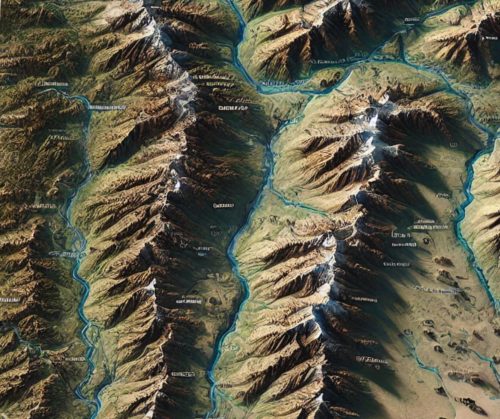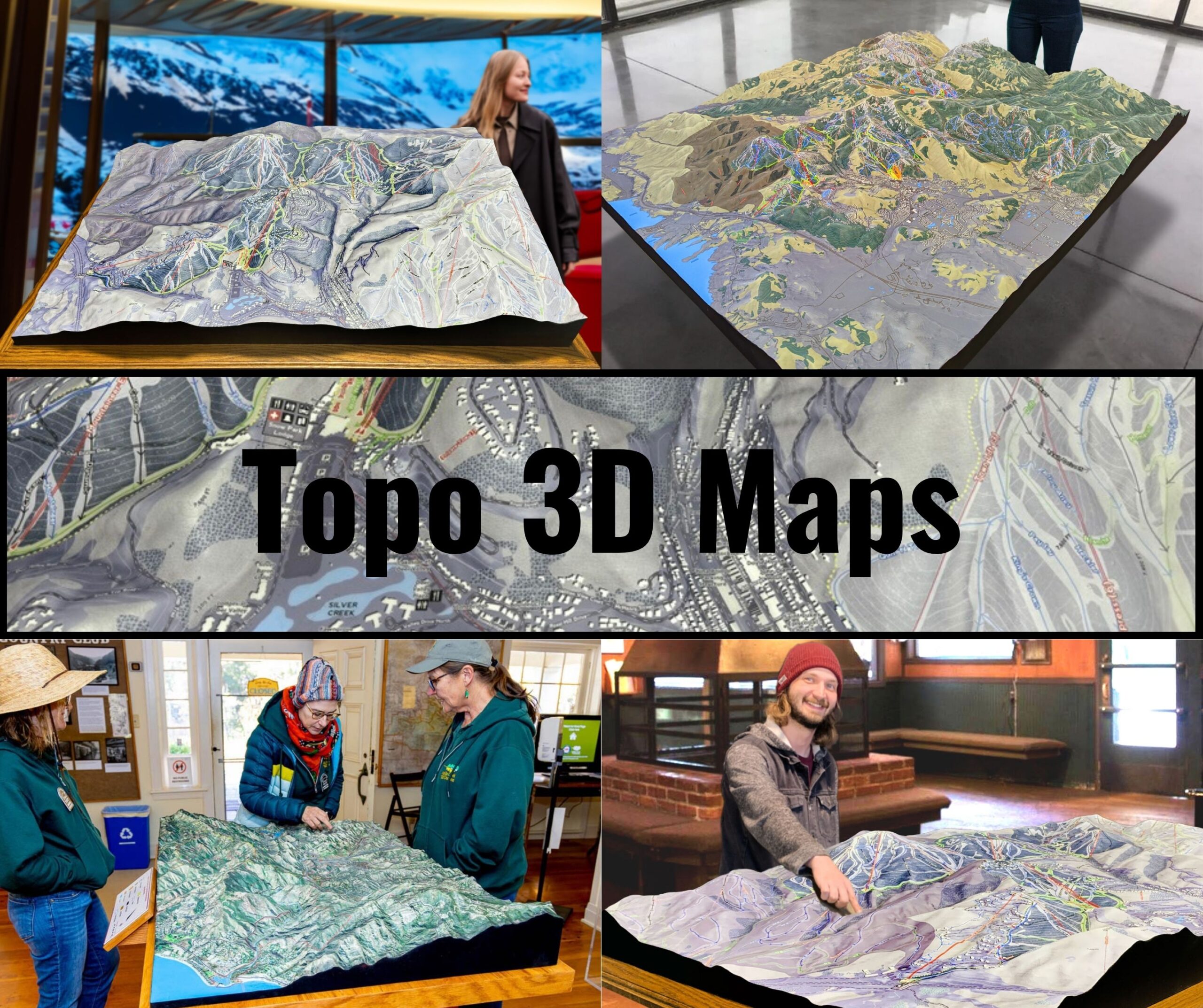Wyoming Topo Map
Wyoming Topo Map
We Build Custom 3D Topo Maps
Wyoming Topo Maps: Navigating the Rugged and Beautiful Cowboy State
Wyoming, the Cowboy State, is an awe-inspiring expanse of diverse landscapes. From the towering peaks of the Teton Range to the sprawling grasslands of the High Plains and the geothermal wonders of Yellowstone National Park, Wyoming’s geography is a tapestry of natural beauty and geological intrigue. Topographic maps are essential tools for exploring these vast and varied terrains, offering detailed insights into elevations, water systems, and key features.
Available in both 2D and 3D formats, Wyoming’s topographic maps provide a detailed view of the state’s geography, enabling adventurers, geologists, conservationists, and educators to navigate and understand its unique landscapes. These maps are indispensable for uncovering Wyoming’s hidden wonders and planning safe, memorable expeditions.
The Tetons: Dramatic Peaks and Pristine Wilderness
The Teton Range, part of the Rocky Mountains, dominates Wyoming’s western skyline. This iconic mountain range is home to Grand Teton National Park, which offers breathtaking vistas, rugged trails, and alpine lakes.
In 2D topographic maps, the Tetons are depicted with tightly packed contour lines that illustrate their steep ridges, high peaks, and glacier-carved valleys. Prominent features like Grand Teton, Jenny Lake, and the Snake River are clearly marked.
3D topographic maps bring the Tetons to life, showcasing their dramatic elevation changes and the intricate network of trails that wind through the landscape. These maps are invaluable for hikers, climbers, and geologists studying the region’s unique formations and glacial history.
Yellowstone National Park: Geothermal Marvels and Vast Ecosystems
Yellowstone National Park, spanning the northwest corner of Wyoming, is a world-renowned natural wonder. Known for its geothermal features, such as geysers and hot springs, and its abundant wildlife, Yellowstone is a treasure trove of geological and ecological significance.
In 2D topographic maps, Yellowstone’s volcanic landscape is detailed with contour lines that highlight its geothermal plateaus, river valleys, and towering waterfalls. Features such as Old Faithful, Yellowstone Lake, and the Grand Canyon of the Yellowstone are prominently displayed.
3D topographic maps of Yellowstone emphasize the park’s unique terrain, showcasing the depth of its canyons, the contours of its caldera, and the patterns of its geothermal areas. These maps are essential for scientists, educators, and adventurers alike.
The Wind River Range: A Backcountry Paradise
The Wind River Range, located in western Wyoming, is a rugged and remote wilderness that features high peaks, glacial basins, and over 2,000 alpine lakes. This area is a haven for outdoor enthusiasts seeking solitude and challenge.
In 2D topographic maps, the Wind River Range is represented with contour lines that detail its dramatic ridges and expansive valleys. Features such as Gannett Peak (Wyoming’s highest point), Titcomb Basin, and Fremont Glacier are clearly marked.
3D topographic maps of the Wind River Range bring its untamed beauty to life, highlighting the elevation changes of its peaks, the depth of its glacial valleys, and the pathways of its numerous trails. These maps are essential for planning backpacking trips and understanding the region’s geological significance.
The High Plains: Rolling Grasslands and Hidden Wonders
The High Plains cover much of eastern Wyoming, offering vast grasslands, subtle elevation changes, and dramatic river valleys. This region contrasts sharply with the mountainous west, showcasing a different kind of beauty.
In 2D topographic maps, the High Plains are depicted with gently curving contour lines that illustrate their rolling terrain and scattered buttes. Features like Thunder Basin National Grassland, Devils Tower, and the Platte River are clearly displayed.
3D topographic maps of the High Plains emphasize the transitions between plains and river valleys, the depth of its canyons, and the subtle elevation changes across the region. These maps are invaluable for understanding the ecological and historical importance of this expansive area.
Wyoming’s River Systems: Lifelines Through the Landscape
Wyoming’s rivers, including the Snake, Green, and Platte Rivers, are integral to the state’s geography and ecology. These waterways carve through mountains, create fertile valleys, and provide vital habitats for wildlife.
In 2D topographic maps, Wyoming’s river systems are detailed with contour lines that illustrate their elevation changes and surrounding terrain. Tributaries, reservoirs, and key features like Flaming Gorge and Jackson Lake are prominently marked.
3D topographic maps of Wyoming’s river systems enhance the understanding of their flow patterns, emphasizing the depth of river channels, the height of surrounding cliffs, and the extent of their floodplains. These maps are essential for water resource management, navigation, and outdoor recreation.
The Bighorn Mountains: A Geological Wonderland
The Bighorn Mountains, located in north-central Wyoming, offer dramatic cliffs, rolling plateaus, and lush forests. This smaller range is packed with opportunities for adventure and discovery.
In 2D topographic maps, the Bighorn Mountains are represented with contour lines that detail their steep slopes, river systems, and expansive meadows. Features such as Cloud Peak, Medicine Wheel, and Shell Falls are prominently displayed.
3D topographic maps of the Bighorn Mountains highlight the intricate topography of the range, showcasing the depth of its canyons, the height of its peaks, and the flow of its rivers. These maps are perfect for geologists, conservationists, and outdoor enthusiasts.
How Wyoming Topo Maps Are Fabricated: From Data to Precision Mapping
Creating topographic maps of Wyoming is a complex process that combines cutting-edge technology, meticulous data collection, and expert craftsmanship. Wyoming’s varied terrain, from its towering peaks to its rolling plains, demands high levels of accuracy and detail.
The 2D Mapping Process
The process of creating 2D topographic maps begins with data collection using satellite imagery, aerial surveys, and LiDAR (Light Detection and Ranging). This data is processed with Geographic Information Systems (GIS) software to produce contour lines that represent changes in elevation. For Wyoming, special attention is paid to capturing the rugged peaks of the Tetons, the expansive basins of Yellowstone, and the subtle terrain of the High Plains. Additional features like roads, trails, and landmarks are added to make the maps more practical and user-friendly.
The 3D Mapping Process
3D topographic maps are crafted by converting elevation data into three-dimensional models. Advanced software generates digital 3D representations, which can then be printed using 3D printers or displayed digitally for interactive exploration. In Wyoming, features like the depth of Yellowstone’s caldera, the jagged ridges of the Wind River Range, and the patterns of river systems are given special attention.
Once printed, 3D maps are often painted and finished to emphasize key elements such as elevation changes, water bodies, and vegetation. These maps are not only visually stunning but also highly functional, providing a tactile and immersive way to explore Wyoming’s landscapes.
Wyoming Topo Maps for Conservation, Recreation, and Education
Topographic maps play a crucial role in conserving Wyoming’s natural resources, supporting outdoor recreation, and educating people about the state’s geography. With its vast wilderness and iconic landmarks, Wyoming requires careful stewardship to protect its environment and heritage.
Conservation Applications
Conservationists use topographic maps to monitor changes in Wyoming’s environment, plan restoration projects, and protect critical habitats. For instance, in Yellowstone, these maps are essential for studying geothermal activity and managing wildlife corridors. In the Wind River Range, they aid in preserving fragile alpine ecosystems.
Recreational Uses
For adventurers, topographic maps are invaluable tools for exploring Wyoming’s trails, waterways, and remote areas. Hikers rely on these maps to navigate the Tetons or Bighorn Mountains, while paddlers use them to plan routes along the Snake or Green Rivers. These maps also guide hunters, anglers, and climbers in finding the best spots for their activities.
Educational Value
Educators and students use topographic maps to study Wyoming’s unique geography, geology, and ecosystems. These maps provide a hands-on way to learn about the state’s glacial history, volcanic features, and diverse landscapes, fostering a deeper understanding of the natural world.
Conclusion: Wyoming’s Landscapes Through the Lens of Topographic Maps
Wyoming’s topographic maps reveal the state’s breathtaking landscapes in stunning detail. From the jagged peaks of the Tetons to the geothermal marvels of Yellowstone, the rolling High Plains, and the serene lakes of the Wind River Range, these maps capture the beauty and complexity of the Cowboy State.
Whether you’re an adventurer seeking to explore Wyoming’s natural wonders, a scientist studying its ecosystems, or an educator teaching about its geography, topographic maps provide an invaluable tool for understanding and appreciating this remarkable state. With both 2D and 3D options available, these maps ensure that future generations can continue to explore, protect, and enjoy the landscapes that make Wyoming unique.
Check out WhiteClouds’ 3D Maps for more information on Wyoming topo maps.

